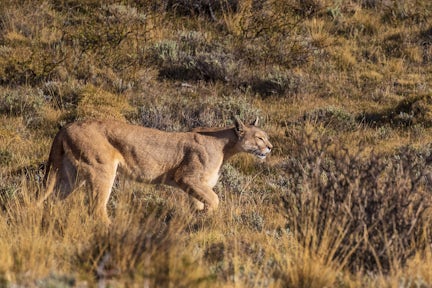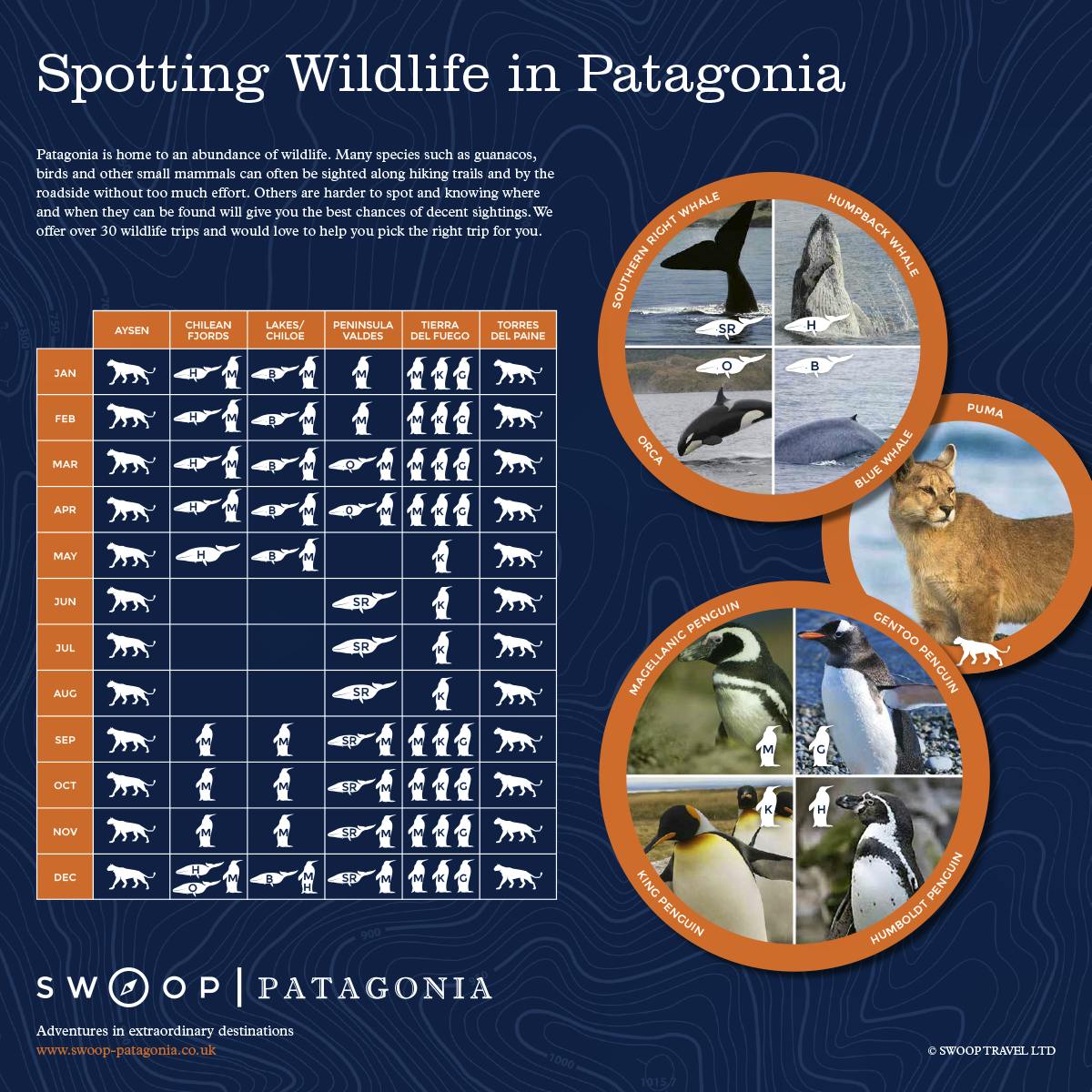Mammals

Explore Patagonia’s diverse mammal species, focusing on the iconic Andean puma, guanacos, and the endangered huemul deer, alongside other wildlife like foxes, armadillos, and …
Discover MoreDeep roots in Patagonia: We are ex-guides, tour leaders, outdoor enthusiasts, & adventurers.
We’ve got our feet on the ground: Impartial advice, a bespoke service, and at no extra cost.
For the ends of the Earth: Sustainability is more than our carbon footprint (but we’re reducing that too).

Patagonia’s vast wilderness is home to an incredible array of wildlife, from elusive cats to waddling penguins and soaring condors. We hope you will be lucky enough to experience exciting animal encounters during your time in Chile and Argentina. Whether exploring windswept steppes, Andean peaks, or Atlantic coastlines, keep your ears pricked and eyes peeled.









Please note - The sighting percentages are intended to be fun estimates from our Wildlife Specialists. Sightings will, of course, depend on your location in Patagonia, the time of the season and other factors. Please reach out to your Customer Experience Coordinator if you would like to learn more.
Huemul Deer - 13% of seeing one in Los Glaciares National Park.
Guanaco - 99% chance of seeing them in Torres del Paine National Park.
King Penguin - 85% chance of seeing them in Tierra del Fuego (check your travel dates carefully).
Mountain Viscacha - 45% chance of seeing one in Patagonia National Park.
Photo credit: Harlequeen
Lesser Rhea - 90% chance in Torres del Paine, Los Glaciares, or Patagonia National Park.
Puma - 51% chance of seeing them in Torres del Paine National Park.
Magellanic Woodpecker - 26% chance of catching one with your binoculars in Patagonia.
South American Fur Seal - 67% chance of seeing one in the Beagle Channel.
Magellanic Penguin - 90–100% at key colonies like Punta Tombo and Isla Magdalena as long as it's during the breeding season (September–March).
Condor - 96% chance of seeing them in Torres del Paine National Park (as long as your eyesight is good or you have a decent set of binoculars!)
One of Patagonia’s most iconic inhabitants is the puma, South America’s largest wild cat. Torres del Paine National Park is one of the best places in the world to spot these elusive predators, often seen stalking guanacos, their primary prey. Guanacos, closely related to llamas, roam Patagonia’s grasslands in large herds, using their keen eyesight and speed to evade predators.
Other land mammals include the Andean fox, often seen trotting along hiking trails, and the Patagonian mara, a large rodent resembling a small deer. Look out for the hog-nosed skunk and the armadillo, both of which are common in Patagonia’s shrublands.

A puma on the hunt
Puma tracking in Patagonia is a thrilling experience, but preparation is key to making the most of your adventure. Expect long hours of walking across rugged terrain, often windy conditions. Sturdy hiking boots, layered clothing, and waterproof gear are essential. Sunrise and sunset are prime times for sightings, requiring patience and keen observation skills.
Nicolas Araya Customer Operations Specialist
Bird enthusiasts will be captivated by Patagonia’s avian residents. Towering above them all is the Andean condor, one of the world’s largest flying birds, effortlessly gliding on thermal currents. Caracaras and eagles are frequently seen hunting across the plains, while the Magellanic woodpecker, with its striking redhead, is a sought-after sighting in the region’s forests.
Along the coasts, Magellanic penguins nest in colonies, particularly at Peninsula Valdés. The rarer king penguin can also be found in a colony Tierra del Fuego. Cormorants, black-browed albatrosses, and ducks thrive in Patagonia’s wild and windswept coastal regions.

Two adult king penguins
Patagonia’s nutrient-rich waters are teeming with marine life. The Valdés Peninsula is a hotspot for southern right whales, which gather to breed and calve in the calm waters from June to December. Orcas, known for their unique hunting techniques, can be seen along the coast, particularly around Punta Norte.
Dolphins, including the playful Peale’s dolphin and striking Commerson’s dolphin, can often be spotted riding the bow waves of boats. Patagonia is also home to vast colonies of South American sea lions and elephant seals, which haul out on remote beaches and rocky shores.

A humpback whale breaches off the Chilean coastline
If you manage to get a good photo of a whale, please submit it online to the Happy Whale Project – a citizen science project that aims to track these cetaceans around the globe.
Marcela Benegas Customer Experience Coordinator

Sustainable travel in Patagonia hinges on respecting and protecting its delicate ecosystem.

Explore Patagonia’s diverse mammal species, focusing on the iconic Andean puma, guanacos, and the endangered huemul deer, alongside other wildlife like foxes, armadillos, and …
Discover More
Learn about the birds that you can see while travelling in Patagonia. The chances of a sighting will vary based on the season, location and species.
Discover More.jpg?auto=format,enhance,compress&fit=crop&crop=entropy,faces,focalpoint&w=580&h=300)
This page highlights the incredible marine life along Patagonia’s coast, from whales and dolphins to penguins and sea lions. It showcases the region’s rich biodiversity and the…
Discover More